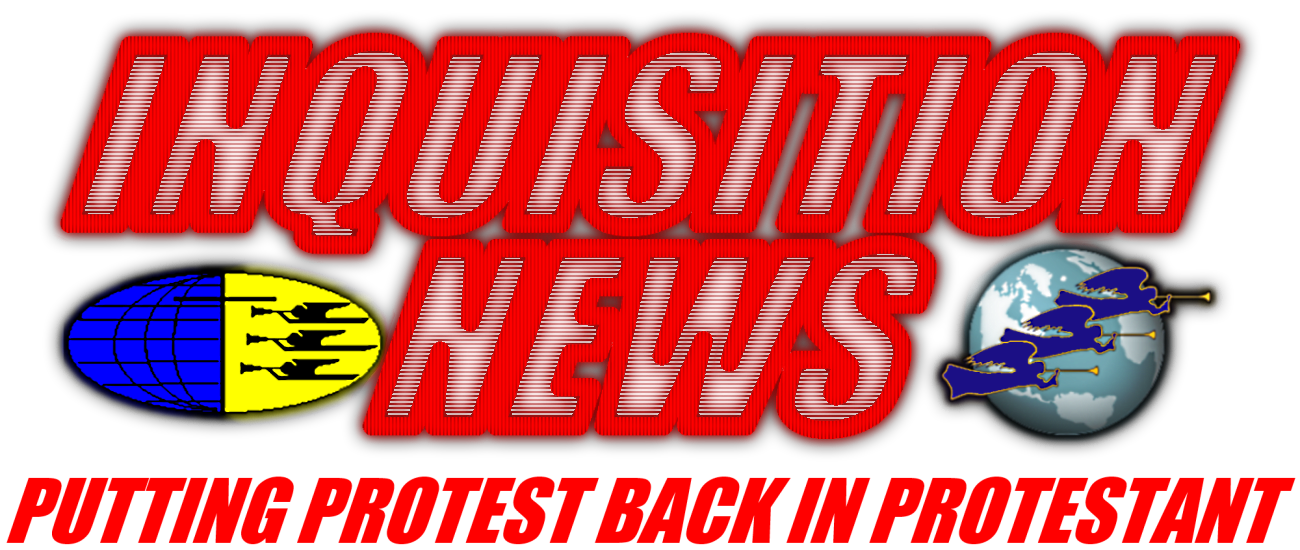by Pastor Hal Mayer Speaker / Director
Tony Palmer, an evangelical friend of Pope Francis, died in a
motorcycle accident. Francis sent a message to be read at his funeral
by his wife, Emiliana. Ironically, he was buried in a Catholic cemetery
in Bath, England after a Catholic Requiem Mass attended by mostly
evangelicals. He really wanted to be a Catholic, so he got his wish in
his death.
Palmer had a passion to bring Evangelicals and Pentecostals into visible unity with Rome. He and the pope made a video for Kenneth Copeland’s ministerial conference in Texas earlier in 2014. During that meeting, Palmer told the audience, many of whom did not know, that the Catholic and Lutheran Churches had signed a declaration in 1999 saying they now agreed on the doctrine of justification by faith.
“We preach the same Gospel now,” Palmer told the gathering. “The protest is over.” The Pentecostals reacted rapturously. Copeland burst into speaking in “gibberish,” often wrongly referred to as speaking in tongues.
After sharing the video with 3,000 Pentecostal pastors in February, it went viral on YouTube. Palmer was inundated by requests from evangelical leaders to be included in the “convergence” movement, as it is sometimes called. Palmer cancelled his teaching commitments and other personal studies in order to keep up with the correspondence. He updated Pope Francis in a meeting in April. The pope expressed his amazement.
Palmer took a group of evangelical leaders who together reach more than 700 million people to meet and lunch with Francis. The delegates included Copeland, James Robison, Geoff Tunnicliffe (head of the Worldwide Evangelical Alliance), and others. They told Francis they wanted to accept his invitation to seek visible unity with the Bishop of Rome and presented him with a proposed Declaration of Faith in Unity for Mission that the evangelicals had drawn up. They proposed that the Vatican and the leaders of major Protestant churches would sign it in Rome in 2017 on the 500th anniversary of the Reformation. Significantly, it would also be the 50th anniversary of the Catholic Charismatic Renewal.
The draft Declaration has three elements: the Nicean-Constantinople Creed, which Catholics and evangelicals apparently share; the core of the Catholic-Lutheran declaration of 1999 stating there is no disagreement over justification by faith; as well as a final section asserting that Catholics and evangelicals are now “united in mission because we are declaring the same Gospel.”
In addition, there is a section about freedom of conscience and that Catholics and evangelicals will respect each other’s mission fields and not treat each other as rivals. That basically means that they will not try to proselytize each other and compete in each other’s territory. This would prevent the declaration that the Papacy is the spiritual Babylon described in the book of Revelation and the appeal to come out of her and be faithful to Christ (Revelation 18:4).
Protestants that adopt visible unity with Rome cannot preach the truth of scripture. They have given up the very Bible principles and teachings that made them Protestant in the first place. Rome’s teachings are still what they always were, the wine of Babylon that makes them and the kings of the earth and multitudes of people spiritually drunk. They are blind to the real teachings of Rome.
The aim of the ecumenical movement is full, visible, doctrinal and sacramental unity with the Catholic Church. When traditional Protestant and Pentecostal churches seek visible unity with Rome, the ecumenical movement is nearing its maturity. Protestants have yielded the field.
“In the movements now in progress in the United States to secure for the institutions and usages of the church the support of the state, Protestants are following in the steps of papists. Nay, more, they are opening the door for the papacy to regain in Protestant America the supremacy which she has lost in the Old World.” Great Controversy, page 573 Most people have no idea that Sunday worship is the bond that links Rome and the evangelicals together. Because evangelicals do not keep the seventh-day Sabbath, that bond of unity with Rome draws them back together. Evangelicals cannot claim that they follow the Bible and the Bible only. Therefore, inevitably and eventually they will return to Rome. They are now enthusiastically doing that.
“When the leading churches of the United States, uniting upon such points of doctrine as are held by them in common, shall influence the state to enforce their decrees and to sustain their institutions, then Protestant America will have formed an image of the Roman hierarchy, and the infliction of civil penalties upon dissenters will inevitably result.” Great Controversy, page 445
http://ktfnews.com/tony-palmer-collapse-protestantism/Palmer had a passion to bring Evangelicals and Pentecostals into visible unity with Rome. He and the pope made a video for Kenneth Copeland’s ministerial conference in Texas earlier in 2014. During that meeting, Palmer told the audience, many of whom did not know, that the Catholic and Lutheran Churches had signed a declaration in 1999 saying they now agreed on the doctrine of justification by faith.
“We preach the same Gospel now,” Palmer told the gathering. “The protest is over.” The Pentecostals reacted rapturously. Copeland burst into speaking in “gibberish,” often wrongly referred to as speaking in tongues.
After sharing the video with 3,000 Pentecostal pastors in February, it went viral on YouTube. Palmer was inundated by requests from evangelical leaders to be included in the “convergence” movement, as it is sometimes called. Palmer cancelled his teaching commitments and other personal studies in order to keep up with the correspondence. He updated Pope Francis in a meeting in April. The pope expressed his amazement.
Palmer took a group of evangelical leaders who together reach more than 700 million people to meet and lunch with Francis. The delegates included Copeland, James Robison, Geoff Tunnicliffe (head of the Worldwide Evangelical Alliance), and others. They told Francis they wanted to accept his invitation to seek visible unity with the Bishop of Rome and presented him with a proposed Declaration of Faith in Unity for Mission that the evangelicals had drawn up. They proposed that the Vatican and the leaders of major Protestant churches would sign it in Rome in 2017 on the 500th anniversary of the Reformation. Significantly, it would also be the 50th anniversary of the Catholic Charismatic Renewal.
The draft Declaration has three elements: the Nicean-Constantinople Creed, which Catholics and evangelicals apparently share; the core of the Catholic-Lutheran declaration of 1999 stating there is no disagreement over justification by faith; as well as a final section asserting that Catholics and evangelicals are now “united in mission because we are declaring the same Gospel.”
In addition, there is a section about freedom of conscience and that Catholics and evangelicals will respect each other’s mission fields and not treat each other as rivals. That basically means that they will not try to proselytize each other and compete in each other’s territory. This would prevent the declaration that the Papacy is the spiritual Babylon described in the book of Revelation and the appeal to come out of her and be faithful to Christ (Revelation 18:4).
Protestants that adopt visible unity with Rome cannot preach the truth of scripture. They have given up the very Bible principles and teachings that made them Protestant in the first place. Rome’s teachings are still what they always were, the wine of Babylon that makes them and the kings of the earth and multitudes of people spiritually drunk. They are blind to the real teachings of Rome.
The aim of the ecumenical movement is full, visible, doctrinal and sacramental unity with the Catholic Church. When traditional Protestant and Pentecostal churches seek visible unity with Rome, the ecumenical movement is nearing its maturity. Protestants have yielded the field.
“In the movements now in progress in the United States to secure for the institutions and usages of the church the support of the state, Protestants are following in the steps of papists. Nay, more, they are opening the door for the papacy to regain in Protestant America the supremacy which she has lost in the Old World.” Great Controversy, page 573 Most people have no idea that Sunday worship is the bond that links Rome and the evangelicals together. Because evangelicals do not keep the seventh-day Sabbath, that bond of unity with Rome draws them back together. Evangelicals cannot claim that they follow the Bible and the Bible only. Therefore, inevitably and eventually they will return to Rome. They are now enthusiastically doing that.
“When the leading churches of the United States, uniting upon such points of doctrine as are held by them in common, shall influence the state to enforce their decrees and to sustain their institutions, then Protestant America will have formed an image of the Roman hierarchy, and the infliction of civil penalties upon dissenters will inevitably result.” Great Controversy, page 445

